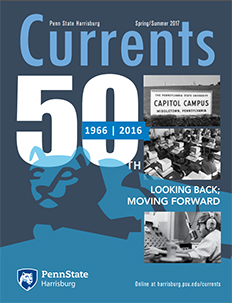 When Penn State Harrisburg officials began thinking about the design of the new Student Enrichment Center and it’s eatery, they looked no further than the college’s top secret military past and the mission that would protect the President of the United States in case of nuclear warfare during the Cold War. Its name: “The Outpost Mission”
When Penn State Harrisburg officials began thinking about the design of the new Student Enrichment Center and it’s eatery, they looked no further than the college’s top secret military past and the mission that would protect the President of the United States in case of nuclear warfare during the Cold War. Its name: “The Outpost Mission”
Tucked away in a top secret government file, one so secret that only the United States president and a select group of officials knew of its existence, were the “Doomsday Blueprints,” a plan outlining procedures for protecting the president in the case of nuclear warfare with the Soviet Union during the Cold War. At the center of these escape plans was the location of Penn State Harrisburg, at the time the Olmsted Air Force Base, where an undercover squadron was stationed for the emergency evacuation of the president.
The “Doomsday Blueprints” were disclosed to the public in 1992, in an article published by Time Magazine, that detailed the elaborate system developed to protect the executive branch, which began with the establishment of the 2857th Test Squadron, an elite unit of helicopter pilots and crew men stationed at Olmsted.
They were disguised as a search and rescue team; only the White House and squadron members knew their true purpose: flying to Washington, D.C. and evacuating the president to safety. The evacuation plans were known as the “Outpost Mission” in the blueprints, and because Olmsted fell just outside of the blast radius of an attack on Washington, the base was the perfect location to house a secret squadron. After securing the president, the idea was to take him to a secure place, including a complex in Gettysburg, Pennsylvania or a bunker in Berryville, Virginia.
Using their search and rescue team guise, the squadron performed regular test runs at Olmsted outfitted in full gear: blast visors to protect the eyes from an atomic flash, boots, gloves, and rubber bodysuits saturated with lead to protect from radiation. The gear totaled almost 20 pounds per person.
Though the Air Force base was converted into a college campus in 1966 and the “Outpost Mission” was decommissioned entirely in 1970, traces of the history were incorporated into the design of the new Student Enrichment Center; the new eatery was dubbed The Outpost, directly named after the infamous evacuation plans. In addition to the helicopters painted on the eatery logo, “2857th” also appears as a tribute to the campus’ rich history.
A nod to our military past
Other namesakes from the college location’s history around campus include the Olmsted building, named after First Lieutenant Robert Sanford Olmsted. Olmsted was killed in an international balloon race in Belgium when his balloon was struck by lightning over the Netherlands. He had been stationed at the Air Force base since 1919.
Several roads on campus in the former Meade Heights area carry the names of commanding officers stationed at Olmsted, including Nelson Drive, named after first commanding officer Lieutenant Colonel George E. Nelson; Jones Street, named after Major Roy M. Jones; Weaver Avenue, named after Major Walter R. Weaver; Flickinger Street, named after Captain Harrison W. Flickinger; and Mars Drive, named after Colonel James A. Mars. Church and Wrisberg Halls were named after Captain Kenneth L. Church and Captain John Wrisberg, who died during a test flight from Olmsted in 1960.
